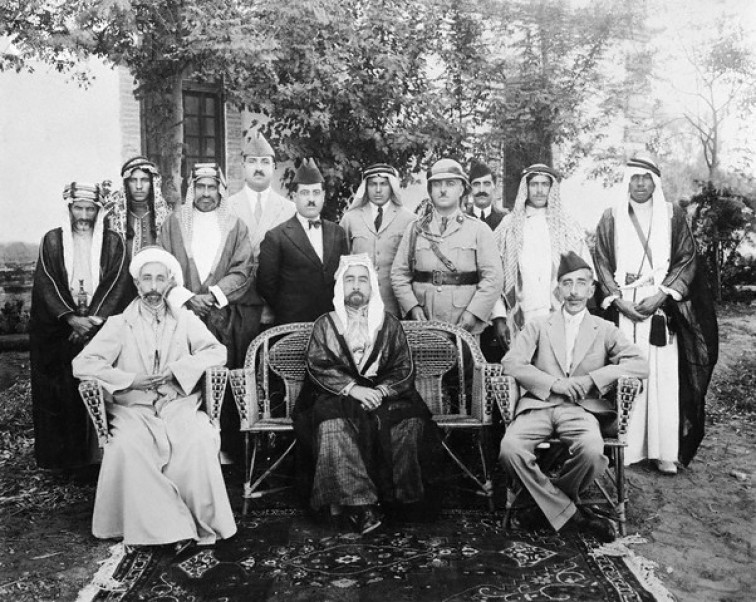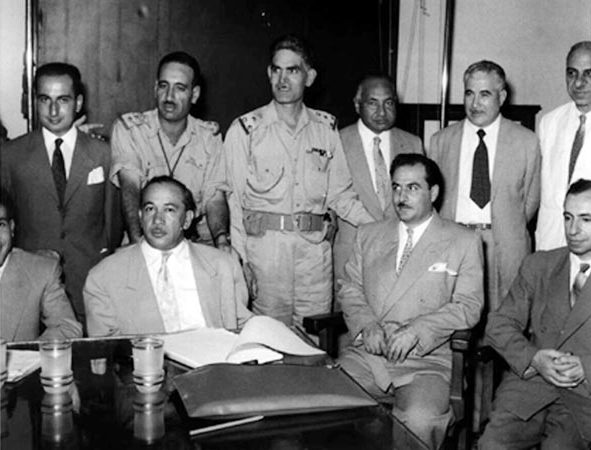|
Hashimites
The Hashemites (), also House of Hashim, are the royal family of Jordan, which they have ruled since 1921, and were the royal family of the kingdoms of Hejaz (1916–1925), Syria (1920), and Iraq (1921–1958). The family had ruled the city of Mecca continuously from the 10th century, primarily as vassals of outside powers, and ruled the thrones of the Hejaz, Syria, Iraq, and Jordan following their World War I alliance with the British Empire. The family belongs to the Dhawu Awn, one of the branches of the Ḥasanid Sharifs of Mecca, also referred to as Hashemites. Their eponymous ancestor is traditionally considered to be Hashim ibn Abd Manaf, great-grandfather of the Islamic prophet Muhammad. Another claimed ancestor is Ali ibn Abi Talib, the usurped successor of the prophet Muhammad according to Shia Islam. The Ḥasanid Sharifs of Mecca (from whom the Hashemite royal family is directly descended), including the Hashemites' ancestor Qatadah ibn Idris, were Zaydī Shīʿas ... [...More Info...] [...Related Items...] OR: [Wikipedia] [Google] [Baidu] [Amazon] |
Banu Hashim
Banu Hashim () is an Arab clan within the Quraysh tribe to which the Islamic prophet Muhammad belonged, named after Muhammad's great-grandfather Hashim ibn Abd Manaf. Members of this clan, and especially their descendants, are also referred to as Hashemites, Hashimites, Hashimids, or Bakara and often carry the surname . These descendants, and especially those tracing their lineage to Muhammad through his daughter Fatima, hold the traditional title of (often synonymous to ). From the 8th century on, Hashimid descent came to be regarded as a mark of nobility, and formed the basis upon which many dynasties legitimized their rule. Some of the most famous Islamic dynasties of Hashimid descent include the Abbasids (ruled from Baghdad 750–945; held the caliphate without exercising power 945–1258 in Baghdad and 1261–1517 in Cairo), the Fatimids (ruled from Cairo and claimed the caliphate 909–1171), the 'Alawi (rulers of Morocco, 1631–present), and the Hashemites (r ... [...More Info...] [...Related Items...] OR: [Wikipedia] [Google] [Baidu] [Amazon] |
Hussein Bin Ali, Sharif Of Mecca
Hussein bin Ali al-Hashimi ( ; 1 May 18544 June 1931) was an Arab leader from the Banu Qatadah branch of the Banu Hashim clan who was the Sharif and Emir of Mecca from 1908 and, after proclaiming the Great Arab Revolt against the Ottoman Empire, King of the Hejaz, even if he refused this title,Representation Of Hedjaz At The Peace Conference: Hussein Bin Ali's Correspondence With Colonel Wilson; Status Of Arabic Countries; King's Rejection Of 'Hedjaz' Title. Paris Peace Conference 1919: Representation Of Hedjaz, Feb. 24, 1919, Manuscript Number FO 608/97-0068 The National Archives (Kew, United Kingdom) from 1916 to 1924. He proclaimed himself Caliph after the abolition of the Ottoman Caliphate in 1924 and stayed in power until 1925 when Hejaz was invaded by the Saudis. His Caliphate was opposed by the British and French empires, the Zionists and the Wahhabis alike. However, he received support from a large part of the Muslim population of that time. and from Mehmed VI ... [...More Info...] [...Related Items...] OR: [Wikipedia] [Google] [Baidu] [Amazon] |
Sharifian Caliphate
The Sharifian Caliphate () was a Caliphate proclaimed by the Sharifian leaders of the Hejaz in 1924, replacing the Ottoman Caliphate, which was abolished by Mustafa Kemal Atatürk. Even though the Banu Hashim held the caliphate at various points in history, Hussein bin Ali, the Sharif of Mecca, was the first and last caliph of this lineage.. In the Arab world, it represented the culmination of a long struggle to reclaim the caliphate from Ottoman hands. The first Arab revolts challenging the validity of the Ottoman caliphate and demanding that an Arab Sayyid be chosen as caliph can be traced back to 1883 when Sheikh Hamat-al-Din seized Sanaa and called for the caliphate as a Sayyid.. However, it was not until the end of the Ottoman caliphate, abolished by the Kemalists, that Hussein bin Ali was proclaimed caliph in March 1924. His stance towards the Ottoman caliphate was multifaceted; while he was hostile to it, he preferred to wait for its official abolition before assuming t ... [...More Info...] [...Related Items...] OR: [Wikipedia] [Google] [Baidu] [Amazon] |
14 July Revolution
The 14 July Revolution, also known as the 1958 Iraqi military coup, was a ''coup d'état'' that took place on 14 July 1958 in Iraq, resulting in the toppling of King Faisal II and the overthrow of the Hashemite-led Kingdom of Iraq. The Iraqi Republic established in its wake ended the Hashemite Arab Federation between Iraq and Jordan that had been established just six months earlier. The Kingdom of Iraq had been a hotbed of Arab nationalism since the Second World War. Unrest mounted amid economic malaise and widespread disapproval of Western influence, which was exacerbated by the formation of the Baghdad Pact in 1955, as well as Faisal's support of the British-led invasion of Egypt during the Suez Crisis. Prime Minister Nuri al-Said's policies were unpopular, particularly within the military ranks. Opposition groups began to organize in secret, modelling themselves after the Egyptian Free Officers Movement that overthrew the Egyptian monarchy in 1952. Pan-Arabic senti ... [...More Info...] [...Related Items...] OR: [Wikipedia] [Google] [Baidu] [Amazon] |
Faisal II
Faisal II (; 2 May 1935 – 14 July 1958) was the last King of Iraq. He reigned from 4 April 1939 until July 1958, when he was killed during the 14 July Revolution. This regicide marked the end of the thirty-seven-year-old Hashemite monarchy in Iraq, which then became a republic. The only son of King Ghazi and Queen Aliya of Iraq, Faisal acceded to the throne at the age of three after his father was killed in a car crash. A regency was set up under his uncle Prince 'Abd al-Ilah. In 1941, a pro-Axis coup d'état overthrew the regent. The British responded by initiating an invasion of Iraq a month later and restored 'Abd al-Ilah to power. During the Second World War, Faisal was evacuated along with his mother to the United Kingdom. There, he attended Harrow School alongside his cousin Hussein, the future King of Jordan. The regency ended in May 1953 when Faisal came of age. The overthrow of the Egyptian monarchy in 1953 and the formation of the United Arab Republic in Fe ... [...More Info...] [...Related Items...] OR: [Wikipedia] [Google] [Baidu] [Amazon] |
Abdullah II Of Jordan
Abdullah II (Abdullah bin Hussein; born 30 January 1962) is King of Jordan, having ascended the throne on 7 February 1999. He is a member of the Hashemites, who have been the reigning royal family of Jordan since 1921, and is traditionally regarded a 41st-generation Hashemites family tree, direct descendant of the prophet Muhammad. Abdullah was born in Amman, as the first child of King Hussein and his wife, Princess Muna. As the king's eldest son, Abdullah was heir apparent until Hussein transferred the title to Abdullah's uncle Prince Hassan bin Talal, Prince Hassan in 1965. Abdullah began his schooling in Amman, continuing his education abroad. He began his military career in 1980 as a training officer in the Jordanian Armed Forces, later assuming command of the country's Joint Special Operations Command (Jordan), Special Forces in 1994, eventually becoming a major general in 1998. In 1993, Abdullah married Rania Al-Yassin, with whom he has four children: Hussein, Crown Princ ... [...More Info...] [...Related Items...] OR: [Wikipedia] [Google] [Baidu] [Amazon] |
Franco-Syrian War
The Franco-Syrian War took place during 1920 between France and the Hashemite rulers of the newly established Arab Kingdom of Syria. During a series of engagements, which climaxed in the Battle of Maysalun, French forces defeated the forces of the Hashemite List of Syrian monarchs, monarch Faisal I of Iraq, King Faisal, and his supporters, entering Damascus on July 24, 1920. A new pro-French government was declared in Syria on July 25, headed by 'Alaa al-Din al-Darubi and the region of Syria (region), Syria was eventually divided into several client states under the Mandate for Syria and the Lebanon. The British government, concerned for their position in the new mandate in Mandatory Iraq, Iraq, agreed to declare the fugitive Faisal as the new king of Iraq. Background Near the end of World War I, the Egyptian Expeditionary forces of Edmund Allenby Capture of Damascus (1918), captured Damascus on September 30, 1918, and shortly thereafter on October 3, 1918, Hashemite ruler Faisal ... [...More Info...] [...Related Items...] OR: [Wikipedia] [Google] [Baidu] [Amazon] |
Saudi Conquest Of Hejaz
The Saudi conquest of Hejaz or the also known as the Hejaz-Nejd War, was a campaign by Abdulaziz al-Saud of the Saudi Sultanate of Nejd to take over the Hashemite Kingdom of Hejaz in 1924–25, ending with conquest and incorporation of Hejaz into the Saudi domain. Background The 1924 campaign came within the scope of the historic conflict between the Hashemites of Hejaz and the Saudis of Riyadh (Nejd), which had already sparked the First Saudi-Hashemite War in 1919. The decisive moment that led to the conquest of the Hejaz was the decision in late 1923 by the British government as an economic measure to cease paying subsidies to both the feuding families of Arabia, namely the al-Hashemites of the Hejaz and the al-Saud of the Nejd. Without the £60,000 annual subsidy in gold coins paid to him by the British government, the principle restraint on Ibn Saud was removed. Likewise, the end of the subsidies amounting to £25,000 gold coins per month to Hussein bin Ali al-Hashemite, ... [...More Info...] [...Related Items...] OR: [Wikipedia] [Google] [Baidu] [Amazon] |
Kingdom Of Hejaz
The Hashemite Kingdom of Hejaz (, ''Al-Mamlakah al-Ḥijāziyyah Al-Hāshimiyyah'') was a state in the Hejaz region of Western Asia that included the western portion of the Arabian Peninsula that was ruled by the Hashemite dynasty. It was self-proclaimed as a kingdom in June 1916 during the First World War, to be independent from the Ottoman Empire, on the basis of an alliance with the British Empire to drive the Ottoman Army from the Arabian Peninsula during the Arab Revolt. The British government had promised Hussein bin Ali, King of Hejaz, a single independent Arab state that would include, in addition to the Hejaz region, modern-day Jordan, Iraq, and most of Syria, with the fate of the Palestine region (today's Israel and Palestine) being mentioned in more ambiguous terms. However, at the end of the First World War, the Treaty of Versailles turned Syria into a French League of Nations mandate and Iraq, Mandate Palestine and Transjordan into British mandates. Hashemi ... [...More Info...] [...Related Items...] OR: [Wikipedia] [Google] [Baidu] [Amazon] |
Ali Of Hejaz
Ali bin Hussein bin Ali al-Hashimi (; 1879 – 13 February 1935), was King of Hejaz and Grand Sharif of Mecca from October 1924 until he was deposed by Ibn Saud in December 1925. He was the eldest son of King Hussein bin Ali and a scion of the Hashemite family. With the passing of the kingship from his father he also became the heir to the title of caliph, but he did not adopt the office and the style of caliph. Early life The eldest son of Hussein, Ali bin Hussein was born in Mecca and was educated at Ghalata Serai College (Galatasaray High School) in Istanbul. His father was appointed Grand Sharif of Mecca by the Ottoman Empire in 1908. However, his relationship with the Young Turks in control of the Empire increasingly became strained, and, in 1916, he became one of the leaders of the Arab Revolt against Turkish rule. Following the Revolt's success, Hussein made himself the first King of Hejaz with British support. While Hussein's sons Abdullah and Faisal were made kings ... [...More Info...] [...Related Items...] OR: [Wikipedia] [Google] [Baidu] [Amazon] |
Hashemite Custodianship Of Jerusalem Holy Sites
Hashemite custodianship refers to the Jordanian royal family's role in tending Muslim and Christian holy sites in the city of Jerusalem. The legacy traces back to 1924 when the Supreme Muslim Council, the highest Muslim body in charge of Muslim community affairs in Mandatory Palestine, chose Hussein bin Ali (Sharif of Mecca) as custodian of Al-Aqsa. The custodianship became a Hashemite legacy administered by consecutive Jordanian kings. Jordan controlled East Jerusalem and the West Bank in 1948, and annexed the territories in 1951 until they were lost to Israel during the 1967 Six-Day War. Jordan renounced claims to the territory in 1988, and signed a peace treaty with Israel in 1994, whose ninth article states that Israel commits to "respect the present special role of the Hashemite Kingdom of Jordan in Muslim Holy shrines in Jerusalem" and that "when negotiations on the permanent status will take place, Israel will give high priority to the Jordanian historic role in thes ... [...More Info...] [...Related Items...] OR: [Wikipedia] [Google] [Baidu] [Amazon] |
Dynasty
A dynasty is a sequence of rulers from the same family, usually in the context of a monarchy, monarchical system, but sometimes also appearing in republics. A dynasty may also be referred to as a "house", "family" or "clan", among others. Historians periodization, periodize the histories of many states and civilizations, such as the Roman Empire (27 BC – AD 1453), History of Iran, Imperial Iran (678 BC – AD 1979), Ancient Egypt (3100–30 BC), and History of China#Ancient China, Ancient and Imperial China (2070 BC – AD 1912), using a framework of successive dynasties. As such, the term "dynasty" may be used to delimit the era during which a family reigned. Before the 18th century, most dynasties throughout the world were traditionally reckoned patrilineality, patrilineally, such as those that followed the Franks, Frankish Salic law. In polities where it was permitted, succession through a daughter usually established a new dynasty in her husband's family name. This has ... [...More Info...] [...Related Items...] OR: [Wikipedia] [Google] [Baidu] [Amazon] |









